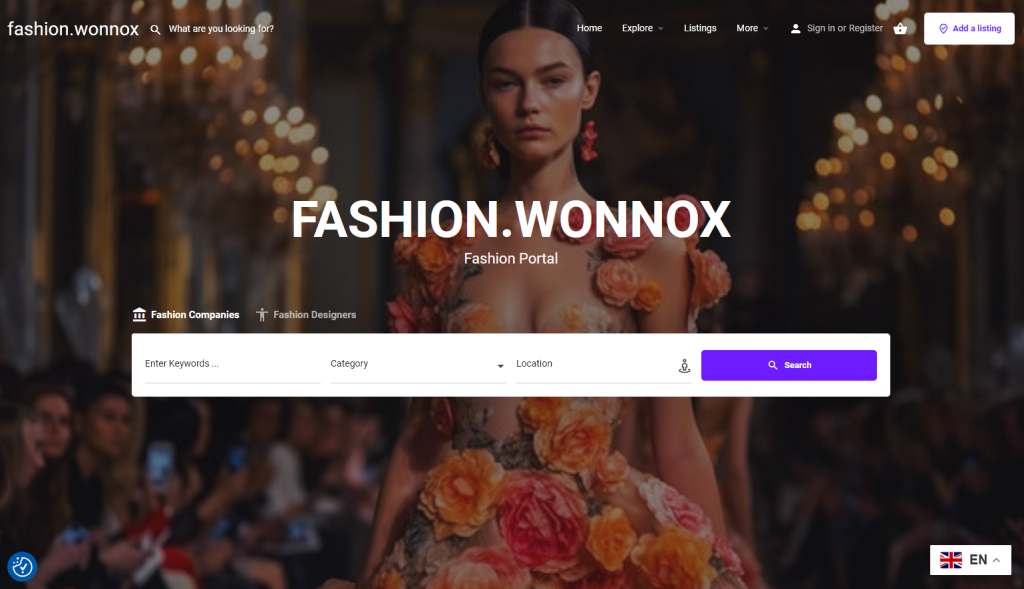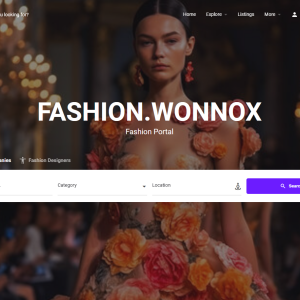
- Direct message
- Leave a review
- Bookmark
- Share
- Report
- prev
- next
Description
A fashion designer’s listing or profile in a web directory within the “fashion” category should present a detailed yet concise overview of their creative vision, expertise, and portfolio. It needs to effectively capture the essence of their design philosophy and style to attract potential clients, collaborators, and fans. Below is a detailed explanation of the features that should be included, structured to fit a 1030-word description:
1. Designer Overview (130 words)
Designer Name: The full name of the fashion designer or brand.
Brand Name (if different): If the designer operates under a brand name distinct from their own.
Tagline or Slogan: A catchy phrase or motto that reflects the designer’s creative vision or aesthetic.
Location: The city and country where the designer is based, as well as the primary location of their studio or atelier.
Years of Experience: Indicates the number of years the designer has been active in the fashion industry, highlighting their level of expertise.
Design Specialization: Describes the designer’s focus, such as haute couture, ready-to-wear, bridal wear, or avant-garde fashion.
Business Model: Explains if the designer caters to custom orders, maintains a ready-to-wear line, or works through a retail distribution model.
2. Design Philosophy and Vision (150 words)
Creative Inspiration: A description of what inspires the designer’s work—this could be cultural influences, nature, architecture, or art.
Design Aesthetic: An overview of the designer’s signature style, such as minimalist, eclectic, romantic, or edgy. It helps convey what sets their designs apart.
Mission Statement: A brief statement that encapsulates the designer’s purpose in the fashion world, like creating timeless pieces or redefining modern luxury.
Vision Statement: Describes long-term goals, such as pushing the boundaries of fashion, expanding globally, or championing sustainable practices.
Core Values: Highlights principles that guide the designer’s work, such as craftsmanship, sustainability, inclusivity, or innovation.
3. Collections and Portfolio (200 words)
Signature Collections: Highlights notable collections or seasons that have defined the designer’s career. This can include capsule collections, collaborative projects, or exclusive runway shows.
Seasonal Lookbooks: A brief description of each recent collection, such as Fall/Winter 2024, Spring/Summer 2025, focusing on the theme, color palette, and standout pieces.
Design Highlights: Mentions specific garments or accessories that have become iconic or best-sellers, such as a particular dress, jacket, or handbag.
Photo Gallery: Includes high-quality images of key designs, providing a visual representation of the designer’s work.
Material Expertise: Details the types of fabrics and materials commonly used, such as silk, leather, recycled fabrics, or hand-embellished textiles, showing the designer's craftsmanship.
Custom Design Services: If the designer offers custom-made garments, such as bridal wear or bespoke evening gowns, this should be highlighted to attract clients looking for personalized creations.
4. Target Audience and Clientele (120 words)
Demographics: Describes the typical customer profile, such as age, gender, lifestyle, and fashion preferences.
Client Types: Identifies whether the designer caters to high-end clients, celebrities, bridal customers, or everyday fashion enthusiasts.
Geographic Focus: Indicates whether the designer serves local markets, has a national reputation, or operates globally.
Market Positioning: States the designer’s position in the fashion market, such as luxury, premium, niche, or accessible.
Notable Clients: Highlights any celebrities, influencers, or high-profile individuals who have worn or commissioned the designer’s work.
5. Sustainability and Ethical Practices (100 words)
Eco-Friendly Materials: Describes the use of sustainable fabrics like organic cotton, recycled polyester, or innovative materials like vegan leather.
Ethical Production: Explains the designer’s commitment to ethical manufacturing practices, such as fair wages, safe working conditions, and small-scale, artisanal production.
Sustainable Design Approach: Details how the designer incorporates sustainability into their design process, such as zero-waste pattern cutting or slow fashion principles.
Certifications: Any relevant certifications, like Fair Trade, GOTS (Global Organic Textile Standard), or membership in sustainable fashion coalitions, add credibility.
Transparency: Emphasizes the designer’s approach to transparency, such as providing information about sourcing and production.
6. Press and Media Recognition (140 words)
Media Mentions: Highlights features in fashion magazines, industry blogs, or news outlets that have covered the designer’s work.
Awards and Accolades: Mentions any awards or recognitions received, such as “Emerging Designer of the Year” or “Sustainable Fashion Innovator.”
Runway Shows: Details about participation in major fashion weeks (e.g., Paris, Milan, New York) or independent showcases that have spotlighted the designer’s collections.
Editorial Features: Mentions specific editorial spreads or photoshoots in prestigious fashion magazines where the designer’s pieces have been featured.
Celebrity Endorsements: If notable figures or celebrities have worn the designer’s creations, this serves as a testament to their appeal and relevance in popular culture.
Online Interviews: Links to video or written interviews where the designer discusses their creative process, inspiration, or thoughts on the fashion industry.
7. Digital Presence (140 words)
Website: A link to the designer’s official website, showcasing collections, contact information, and any e-commerce functionality.
Online Portfolio: Describes key sections of the website, such as an online gallery or blog that features insights into the design process.
E-commerce Features: If applicable, highlights features like an online store, virtual showroom, or custom order page.
Social Media Profiles: Links to active social media channels (Instagram, Facebook, TikTok, LinkedIn), emphasizing where the designer engages most with their audience.
Mobile App (if available): If the designer has a branded app, describe its features, like virtual fitting rooms or exclusive content.
Influencer Collaborations: Mentions partnerships with influencers or style icons that have amplified the designer’s reach on social media.
8. Customer Reviews and Testimonials (80 words)
Client Testimonials: Quotes from satisfied clients, showcasing their experiences with custom orders or off-the-rack pieces.
Review Ratings: If the designer has received positive ratings on platforms like Trustpilot or Google Reviews, it can be highlighted here.
Social Proof: Highlights positive feedback from social media comments or shared images of customers wearing the designer’s pieces.
Case Studies: Short examples of successful collaborations, such as a custom gown for a celebrity red-carpet event or a special project for a high-profile client.
9. Contact Information (70 words)
Studio or Atelier Address: Physical location for clients who may want to visit for consultations or fittings.
Email Address: A direct email for inquiries, collaborations, or press contact.
Phone Number: For appointments or client queries.
Online Contact Form: Link to a contact form for easy online inquiries.
Business Hours: Specifies the best times to reach out for inquiries or consultations.
10. Career Opportunities (60 words)
Job Openings: Information about any job openings or internships in the designer’s studio.
Internship Programs: Details on internship opportunities for those looking to gain experience in fashion design.
Culture and Work Environment: Briefly describes what it’s like to work with the designer, emphasizing aspects like creative freedom, mentorship, or a collaborative environment.
11. Special Promotions and Events (70 words)
Seasonal Sales: Information on any discounts or sales events, such as end-of-season clearances.
Trunk Shows: Details on exclusive events where clients can preview new collections or purchase limited edition pieces.
Pop-Up Stores: Information about any pop-up shops or special retail events where clients can experience the brand firsthand.
Newsletter Sign-Up: A link for visitors to subscribe to updates, new arrivals, and special invitations to events.
12. Visual Content (70 words)
High-Resolution Photos: A selection of professional images showcasing recent collections or standout pieces.
Video Clips: Short videos of runway shows, behind-the-scenes footage, or styling tutorials.
Lookbook: A downloadable or online version of the latest lookbook for potential clients and media to view.
This structure provides a complete view of a fashion designer’s profile, making it both informative and appealing. With a balanced mix of creativity, professionalism, and market relevance, the listing offers potential clients, collaborators, and followers a clear sense of the designer’s unique offerings and expertise.

Add a review